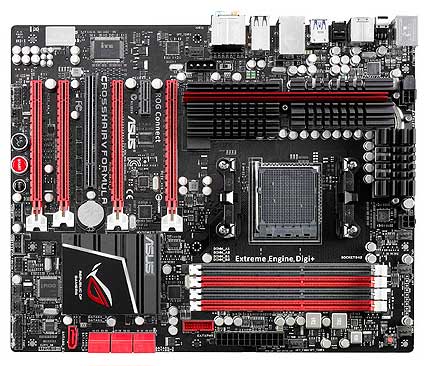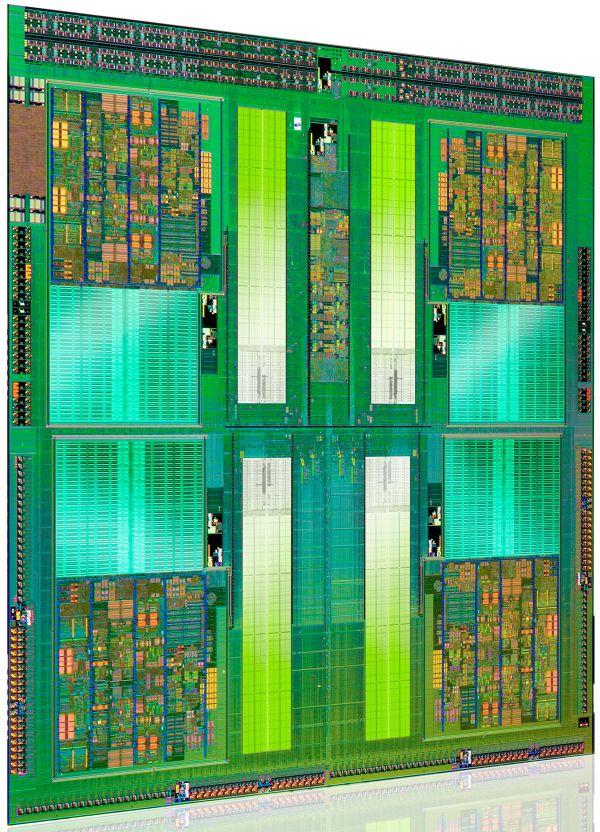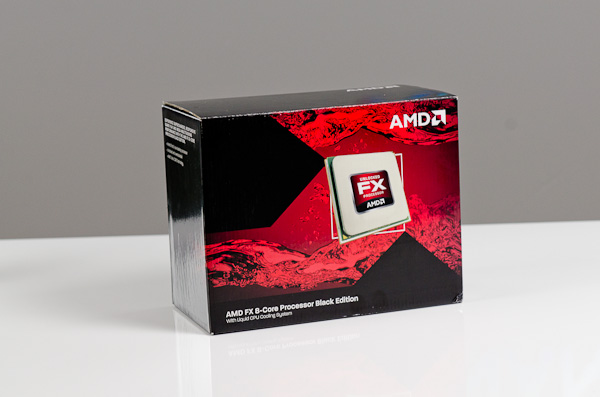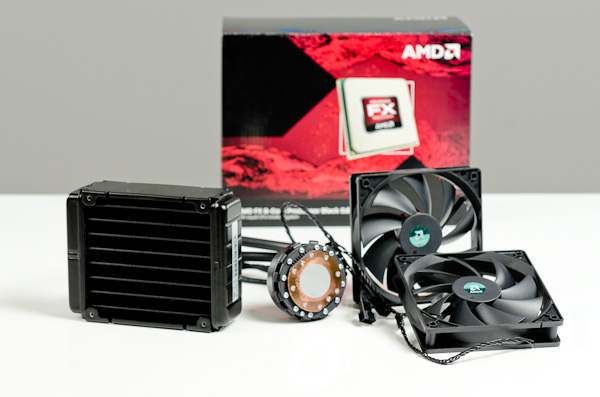The Bulldozer Review: AMD FX-8150 Tested
by Anand Lal Shimpi on October 12, 2011 1:27 AM ESTAMD has been trailing Intel in the x86 performance space for years now. Ever since the introduction of the first Core 2 processors in 2006, AMD hasn't been able to recover and return to the heyday of the Athlon 64 and Athlon 64 X2. Instead the company has remained relevant by driving costs down and competing largely in the sub-$200 microprocessor space. AMD's ability to hold on was largely due to its more-cores-for-less strategy. Thanks to aggressive pricing on its triple and hexa-core parts, for users who needed tons of cores, AMD has been delivering a lot of value over the past couple of years.
Recently however Intel has been able to drive its per-core performance up with Sandy Bridge, where it's becoming increasingly difficult to recommend AMD alternatives with higher core counts. The heavily threaded desktop niche is tough to sell to, particularly when you force users to take a significant hit on single threaded performance in order to achieve value there. For a while now AMD has needed a brand new architecture, something that could lead to dominance in heavily threaded workloads while addressing its deficiencies in lightly threaded consumer workloads. After much waiting, we get that new architecture today. Bulldozer is here.
It's branded the AMD FX processor and it's only available in a single die configuration. Measuring 315mm2 and weighing in at around 2 billion transistors (that's nearly GPU-sized fellas), Bulldozer isn't that much smaller than existing 45nm 6-core Phenom II designs despite being built on Global Foundries' 32nm SOI process. Both die area and transistor count are up significantly over Sandy Bridge, which on Intel's 32nm HKMG process is only 995M transistors with a die size of 216mm2. This is one big chip.
| CPU Specification Comparison | ||||||||
| CPU | Manufacturing Process | Cores | Transistor Count | Die Size | ||||
| AMD Bulldozer 8C | 32nm | 8 | 1.2B* | 315mm2 | ||||
| AMD Thuban 6C | 45nm | 6 | 904M | 346mm2 | ||||
| AMD Deneb 4C | 45nm | 4 | 758M | 258mm2 | ||||
| Intel Gulftown 6C | 32nm | 6 | 1.17B | 240mm2 | ||||
| Intel Nehalem/Bloomfield 4C | 45nm | 4 | 731M | 263mm2 | ||||
| Intel Sandy Bridge 4C | 32nm | 4 | 995M | 216mm2 | ||||
| Intel Lynnfield 4C | 45nm | 4 | 774M | 296mm2 | ||||
| Intel Clarkdale 2C | 32nm | 2 | 384M | 81mm2 | ||||
| Intel Sandy Bridge 2C (GT1) | 32nm | 2 | 504M | 131mm2 | ||||
| Intel Sandy Bridge 2C (GT2) | 32nm | 2 | 624M | 149mm2 | ||||
Update: AMD originally told us Bulldozer was a 2B transistor chip. It has since told us that the 8C Bulldozer is actually 1.2B transistors. The die size is still accurate at 315mm2.
Architecturally Bulldozer is a significant departure from anything we've ever seen before. We'll go into greater detail later on in this piece, but the building block in AMD's latest architecture is the Bulldozer module. Each module features two integer cores and a shared floating point core. FP hardware is larger and used less frequently in desktop (and server workloads), so AMD decided to share it between every two cores rather than offer a 1:1 ratio between int/fp cores on Bulldozer. AMD advertises Bulldozer based FX parts based on the number of integer cores. Thus a two module Bulldozer CPU, has four integer cores (and 2 FP cores) and is thus sold as a quad-core CPU. A four module Bulldozer part with eight integer cores is called an eight-core CPU. There are obvious implications from a performance standpoint, but we'll get to those shortly.
The FX Lineup
There are a total of 7 AMD FX CPUs that AMD is announcing today, although only four are slated for near-term availability.
| CPU Specification Comparison | |||||||||
| Processor | Cores | Clock Speed | Max Turbo | NB Clock | L2 Cache | TDP | Price | ||
| AMD FX-8150 | 8 | 3.6GHz | 4.2GHz | 2.2GHz | 8MB | 125W | $245 | ||
| AMD FX-8120 | 8 | 3.1GHz | 4.0GHz | 2.2GHz | 8MB | 95W/125W | $205 | ||
| AMD FX-8100* | 8 | 2.8GHz | 3.7GHz | 2GHz | 8MB | 95W | N/A | ||
| AMD FX-6100 | 6 | 3.3GHz | 3.9GHz | 2GHz | 6MB | 95W | $165 | ||
| AMD FX-4170* | 4 | 4.2GHz | 4.3GHz | 2.2GHz | 4MB | 125W | N/A | ||
| AMD FX-B4150* | 4 | 3.8GHz | 4GHz | 2.2GHz | 4MB | 95W | N/A | ||
| AMD FX-4100 | 4 | 3.6GHz | 3.8GHz | 2GHz | 4MB | 95W | $115 | ||
| AMD Phenom II X6 1100T | 6 | 3.2GHz | 3.6GHz | 2GHz | 3MB | 125W | $190 | ||
| AMD Phenom II X4 980 | 4 | 3.7GHz | N/A | 2GHz | 2MB | 125W | $170 | ||
The FX-8150, 8120, 6100 and 4100 are what's launching today. The first digit in AMD's FX model numbers indicates the number of cores with the 8150 and 8120 boasting eight, while the 6100 only has six active integer cores (three Bulldozer modules). The FX-4100 features four integer cores. L2 cache scales with core count (2MB per module), while the L3 cache size remains fixed at 8MB regardless of SKU.
North Bridge and L3 cache frequency alternate between 2.0GHz and 2.2GHz depending on the part. TDPs range between 95W and 125W as well, with the FX-8120 being offered in both 125W and 95W versions.
There's only a single Bulldozer die. The 6 and 4 core versions simply feature cores disabled on the die. AMD insists this time around, core unlocking won't be possible on these harvested parts.
The huge gap in clock speed between the 8120 and 8150 are troubling. Typically we see linear frequency graduations but the fact that there's a 16% difference between these two SKUs seems to point to process problems limiting yield at higher frequencies—at least for the 8-core version.
Outside of the quad-core and hex-core Bulldozer pats, the only other FX processor able to exceed the 3.3GHz clock speed of the Phenom II X6 1100T is the 8150. And if you include quad-core Phenom II parts in the mix, only two Bulldozer parts ship at a higher stock frequency than the Phenom II X4 980. Granted Turbo Core will help push frequencies even higher, but these low base frequencies are troubling. For an architecture that was designed to scale to clock speeds 30% higher than its predecessor, Bulldozer doesn't seem to be coming anywhere close.
The entire FX lineup ships unlocked, which allows for some easy overclocking as you'll see soon enough.
Motherboard Compatibility
AMD is certifying its FX processors for use on Socket-AM3+ motherboards. Owners of standard AM3 motherboards may be out of luck, although motherboard manufacturers can choose to certify their boards for use with Bulldozer if they wish to do so. From AMD's perspective however, only AM3+ motherboards with BIOS/UEFI support for Bulldozer are officially supported.
All existing AM2/AM2+/AM3/AM3+ heatsinks should work with the FX processor; they simply need to be rated for the TDP of the processor you're looking to cool.

For this review, AMD supplied us with ASUS' Crosshair V Formula AM3+ motherboard based on AMD's 990FX chipset.
AMD does offer six 6Gbps SATA ports on its 990FX chipset, a significant upgrade from the two 6Gbps ports on Intel's 6-series chipsets. Unbuffered ECC memory is also supported for those who desire the added security, once again a feature not supported on Intel's consumer grade 6-series chipsets.
Despite AMD's trend towards releasing APUs with integrated GPUs (thus requiring a new socket), AMD insists that the AM3+ platform will live to see one more processor generation before it's retired.
AMD's Liquid CPU Cooling System
Alongside its new FX processors AMD is introducing its first branded liquid cooling system manufactured by Asetek.
AMD's cooling system is similar to other offerings from companies like Antec and Corsair. The system is self contained, you never have to worry about adding any more liquid to it.
Attach the cooling module to your CPU socket via a simple bracket, and affix the radiator to your case and you're good to go. The radiator is cooled via two 120mm fans, also included in the box.
AMD doesn't have an exact idea on pricing or availability of its liquid cooling solution, but I'm told to expect it to be around $100 once available. My sample actually arrived less than 12 hours ago, so expect a follow up with performance analysis later this week.
The Roadmap
For the first time in far too long, AMD is actually being very forthcoming about its future plans. At a recent tech day about Bulldozer, AMD laid out its CPU core roadmap through 2014. The code names are below:
Piledriver you already know about, it's at the heart of Trinity, which is the 2—4 core APU due out in early 2012. Piledriver will increase CPU core performance by around 10—15% over Bulldozer, although it will initially appear in a lower performance segment. Remember that final generation of AM3+ CPU I mentioned earlier? I fully expect that to be a GPU-less Piledriver CPU due out sometime in 2012.
Steamroller will follow in 2013, again improving performance (at the core level) by around 10—15%. Excavator will do the same in 2014. AMD believes that these performance increases will be sufficient to keep up with Intel over time, however I'll let you be the judge of that once we get to the Bulldozer performance numbers.
The other thing to note about AMD's roadmap is it effectively puts the x86 business on an annual cadence, in line with what we've seen from the AMD GPU folks. Although AMD isn't talking about what process nodes to expect all of these cores at, it looks like AMD will finally have an answer to Intel's tick-tock release schedule moving forward.























430 Comments
View All Comments
saneblane - Thursday, October 13, 2011 - link
Man, you have a lot of optimism. I am a big Amd fan, but even i can remain optimistic after this mess, I mean how do you make a chip that is slow, expensive and losses to it's older brothers. Barcelona was a huge success compare to this, it only seemed bad because Expectations were high, this time around though they became higher because no one expect Amd to actually go backwards in performance. WOW that's all i can say WOWPipperox - Thursday, October 13, 2011 - link
I don't understand why you all think it's slower than its older brothers.It's not, it's faster than Thuban in practically all benchmarks...
Or do you really care about stuff like SuperPi?
Pipperox - Thursday, October 13, 2011 - link
But maybe you guys think that it's slower "clock for clock" or "core for core".It doesn't matter how you achieve performance.
What matters is the end performance.
Bulldozer architecture allows it to have higher clock speed and more *threads* than Phenom.
The penalty is single threaded performance.
Again you can't compare it to an hypothetical 8 core 4.0GHz Thuban, because they couldn't have made it (and make any money out of it).
I'll repeat, the FX-8150 is NOT an 8-core CPU.
Otherwise the i7-2600K is also an 8-core CPU... both can execute 8 threads in parallel, but each pair of threads shares execution resources.
The main difference is that Sandy Bridge can "join" all the resources of 2 threads to improve the performance of a single thread, while Bulldozer cannot.
They probably didn't do it to reduce HW complexity and allow easier scalability to more threads and higher clock speed.
Because the future (and to a large extent, the present) is heavily multithreaded, and because Bulldozer is targeted mainly at servers. (and the proof is its ridiculous cache)
bryman - Thursday, October 13, 2011 - link
how about some bios screenshots? Is there a way in the bios to disable the northbridge in the chip and use the northbridge on the motherboard? Possibly better performance, or maybe add a new ability to x-fire northbridges? (Yah imah Dreamer). imo, I dont think adding the northbridge to the cpu was a good idea especially if it pulls away from other resources on the chip, I understand what adding the northbridge to the processor does, but does it turn off the northbridge thats already on the motherboard? The northbridge on the chip makes sense for an APU but not for a perfomance CPU, why is the nothbridge even in there. I myself would rather see the northbridge on the motherboard utilizing that space intstead of the space on the cpu.If there isnt a way to turn off the northbridge on the cpu in the bios, i think the motherboard manufactures should include the ability to turn off the northbridge on the cpu. Add the ability to use the onboard northbridge in there bios, so you can atleast get bios or firmware updates to the northbridge and perhaps get more performance out of the cpu/gpu.
When the new Radeon 7000 series video cards come out, if I buy this CPU with the 6000 series northbridge in it, am I going to take a performance hit or am i going to have to buy a new processor with the 7000 series northbridge in it? or will they come out with a 7000 series motherboard that utilizes a 7000 series northbridge that turns off the 6000 series northbridge in the chip, which in turn makes it useless anyways. I myself dont like the fact if i buy this product, if i want to upgrade my northbridge/ motherboard, I might have to buy a new processor/ perhaps a new motherboard or am i just paranoid or not understanding something.
Who knows, maybe in the next couple of weeks, Mcrosoft and/or AMD will come out with a performance driver for the new processors.
If they would have come out with this processor when planned originally, it really would have kicked butt. instead we get conglimerated ideas over the five year period, which looks like the beginning idea, thrown into a 2011 die.
I am i die-hard AMD fanboy and always will be, Just kinda dissappointed, excuse my rants. I will be buying a 4 core when they hit the streets, hopefully in a couple weeks.
saneblane - Thursday, October 13, 2011 - link
From the caching issues, to the bad glofo process, to the windows scheduler, i recon that this processor wasn't ready for prime time. Amd didn't have any choice i mean they almost took an entire year extra for peet sake. Even though my i5 2500 is on it's way, am not stupid enough to believe this is the best the arch can do. Their is a good reason that interlagos cannot be bought in stores, Amd know for a fact that they cannot sell this cpu to server maker, so they are busy working on it, i expect that it might take one or even 2 more stepping to fix this processor, the multithread performance is their so they only need to get a mature 32nm process to crank up the speeds and maintain the power consumptions. IMOarjuna1 - Thursday, October 13, 2011 - link
Reviews @ other sites like toms hardware and guru 3d are starting to make this look bad. How come everyone but Anand got to review it with watercooling?? Is this site in such bad terms with AMD?B3an - Thursday, October 13, 2011 - link
Water cooling isn't magically going to help performance or power consumption in any way so why does it matter?? When you buy this CPU it comes with air cooling, and Anand was right to use that for this review.marcelormt - Thursday, October 13, 2011 - link
http://www.tomshardware.com/reviews/does-amds-athl...Patrick: The 6000+ is the fastest Athlon 64 X2 dual core processor ever, but what happened to the FX family?
Damon: Patrick, you are right. The X2 6000+ is the fastest AMD64 dual-core processor ever... so why isn't it called FX? To answer that I have to explain what FX is all about... pushing the boundaries of desktop PCs. FX-51 did that right out of the gate, with multiple advantages over other AMD processors, and a clear lead on the competition. Move forward a bit to where AMD put high-performance, native dual-core computing into a single socket with the FX-60. Fast forward again and you see FX pushing new boundaries as "4x4" delivers four high-performance cores with a direct-connect, SLI platform that is ready to be upgraded to 8 cores later this year
Ryomitomo - Thursday, October 13, 2011 - link
I'm a little surprised you only posted Win7/Win8 comparison figures for FX-8150. It would give a much complete picture if you would also post i7-2600k Win7/Win8 comparison.czerro - Thursday, October 13, 2011 - link
I think anand handled this review fine. Bulldozer is a little underwhelming, but we still don't know where the platform is going to go from here. Is everyone's memory so short term that they don't remember the rocky SandyBridge start?